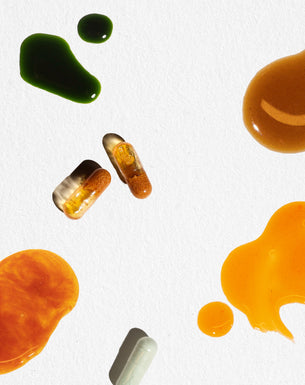
Vitamin D is an essential nutrient that helps us fight disease, regulate our mood, and support our bone health. Our bodies produce vitamin D when our skin is exposed to sunlight. However, we can also get vitamin D through supplements and certain foods.
While all bodies require vitamin D, your nutrient needs are individual to you. To optimize your personal health, let’s take a sunny walk through our guide on how much vitamin D you should take every day.
Vitamin D—What is It?
Vitamin D is one of the fat-soluble vitamins, which means it’s stored inside your fatty tissues and liver for long-term use.1 In contrast, water-soluble vitamins (like vitamin C) are immediately usable and excreted through urine.
Fat-soluble vitamins can be stored like acorns in the winter. They’re your body’s long-term reserves and are stored until your body needs them. In contrast, water-soluble vitamins are immediately used by your body. As such, it may take a few weeks or months for your vitamin D levels to rise after taking vitamin D supplements.2
Let’s see how this nutrient enters and is used by your body.
Roles of Vitamin D
This nutrient has a starring role in our health, supporting everything from sex hormone production to nerve function. As a fat-soluble nutrient, vitamin D is stored and used to help your body:3,4,5,6Vitamin D supplements can also:
- Absorb calcium and phosphorus to build healthy bones and prevent bone density loss
- Lower inflammation to boost immunity and prevent cardiovascular issues
- Control insulin to support healthy blood sugar levels
- Improve nerve and muscle systems to create healthy movement and reactions
- Support brain function to defend against depression and mood disorders
- Regulate enzymes to support sex and adrenal hormone production
- Reduce tumor growth to protect against cancer
Sources of Vitamin D
Unlike other essential nutrients, vitamin D does not come just from food. In fact, this vitamin can be produced by your own body—it just takes a little sunny influence. From birth to old age, your body can increase your vitamin D intake from these three sources:1
- Food – While there are some foods that contain Vitamin D, the majority of food we consume will not contain adequate levels. This nutrient is found in very few plant-based foods, including mushrooms and soy milk. However, the US Food and Drug Administration has approved fortified foods with vitamin D to boost levels. For most, these foods include plant-based milks, cereals, and orange juice.
- Sun exposure – When sunlight touches the skin, our bodies produce vitamin D. As such, medical professionals recommend that you get at least 10 to 15 minutes of sunlight a day.7
- Supplements – If your diet and sun exposure are limited, there are dietary supplements that can save the day. Sold mainly in pill form, vitamin D supplements can help support your overall health.
How Much Vitamin D Should I Take?
For over 115 million Americans, sunshine and food alone just can’t maintain healthy vitamin D levels. Your recent blood work can be an indicator if you fall within this group of individuals. If your doctor mentions a low level of vitamin D at your next physical, then it may be time for you to explore supplementation.
In healthy humans, the standard for blood serum levels of vitamin D stays about the same. However, reaching that healthy level can require different amounts of supplementation. According to National Health Institute, the Recommended Daily Intake (RDI) of vitamin D for each major age group include the following:1
- 0 to 12 months – 400 IU for males and females
- 1 to 13 years – 600 IU for males and females
- 14 to 18 years – 600 IU for males and females
- 19 to 70 years – 600 IU for males and females
- Over 70 years – 800 IU for males and females
While these amounts are standard, certain health conditions can shift your vitamin D supplementation needs.
Did you know that it’s considered safe for humans over nine years old to take up to 4000 IU of vitamin D per day?3 If you’re curious about adding supplements to boost your vitamin levels, consider these conditions as they may change the amount of Vitamin D you can safely consume:
- Breastfeeding – Breastfeeding individuals may wonder how much vitamin D they should consume in a day to maintain healthy levels for both mom and baby. A baby receives all nutrients from the mom for at least a few months of life. While these conditions technically don’t require a higher RDI, research shows that high vitamin D supplementation (4,000 IU) helps support adequate breast milk vitamin D levels in mothers.8
- Bone density loss – With age, bones begin to lose their density and become more susceptible to fractures and injuries. Research suggests that vitamin D supplements of at least 600 IU could reduce hip and non-spine fractures in those ages 65 and up.3
- Multiple Sclerosis (MS) – Research has shown that there is no directly correlation on whether low Vitamin D levels are a cause or symptom of MS. However, studies show that people with the highest vitamin D serum levels had a 62% lower risk of having MS.3
What Is Vitamin D Deficiency?
Without supplementation, people can experience vitamin D deficiency. What’s the difference between a deficiency and an insufficiency? A deficiency is a greater and riskier vitamin decrease, while an insufficiency is a milder (yet still risky) decrease in vitamin levels.
While certain age groups may slightly differ, the standard for normal vitamin D levels remains the same for all people. Typically doctors will slot vitamin D levels into these categories:9
- Deficient – Below 12 ng/mL
- Insufficient – 12 to 20 ng/mL
- Normal – 20 to 50 ng/mL
- Excessive – Above 50 ng/mL
Vitamin D Testing
Vitamin D testing only measures one particular biomarker—serum total 25-hydroxyvitamin D. This molecule reflects your body’s “status” on vitamin D since it marks how much your liver is processing this nutrient.
Symptoms of Low Vitamin D
A vitamin D deficiency can impact our health in several ways. For children, long-term vitamin D deficiency can lead to life-long issues such as:10
- Rickets – A disease (often in young kids) where growing bone tissues fail to mineralize
- Osteomalacia – A condition where existing bones fail to mineralize completely
For adults who develop a vitamin D deficiency later in life, the consequences may not be as drastic. However, common symptoms include:
- Fatigue, usually from poor nutrition overall
- Muscular-skeletal pain, such as cramps, spasms, and joint issues
- Mood changes, often related to depression and low energy
At-Risk People with Low Vitamin D
Vitamin D may be the only nutrient that our bodies produce via solar power. However, that can actually make it harder for certain people to maintain optimal levels. Across the globe, these factors can make it more challenging to get adequate vitamin D intake from either food or sunlight:1,10
- Low-sun environments – The less sun you get, the less vitamin D your body can produce via sunshine. The latitude, time of day, season, altitude, and weather can all change an environment’s sun exposure.
- Sunscreen – It’s obvious to say, but sunscreen does block the type of UV light that creates vitamin D.
- Higher melanin – Populations with darker skin (or higher melanin production) have a harder time synthesizing sunlight into vitamin D. This creates a higher risk of low vitamin D in black populations.
- Digestive conditions – Since vitamin D is a fat-soluble nutrient, digestive conditions that interfere with fat absorption can lower vitamin D levels. These conditions include Crohn’s, Irritable Bowel Syndrome, and celiac disease.
- Obesity – Research shows that people with a body mass index over 30 are more likely to have a low vitamin D level.
- Excessive breastfeeding – When a baby drinks from their mom’s natural milk, they absorb the mom’s nutrient levels. If the mom has inadequate intake of vitamin D, that can leave the baby with poor vitamin D levels.
- Old age – As you age, your skin’s ability to create vitamin D from sunlight decreases. Also, older people are more likely to spend excess time indoors.
How Long Does It Take to Raise Vitamin D Levels?
Starting a new health regimen can be motivating, even exciting. However, you’ll need some patience with vitamin D supplementation: After taking a vitamin D supplement, it will take awhile before you notice increased vitamin D levels.2 That’s because vitamin D is stored in your fat, and it’s not readily available to your body.
As a fat-soluble nutrient, vitamin D is not quickly absorbed, used, or excreted by the body. Even with daily supplementation, it can take anywhere from 1 to 6 months to see testable results and physical changes.2 However, this timeline can shift slightly based on the following:
- Supplement dose
- Age
- Weight and physical activity
- Genetics
- Other medications
- Digestive issues
Supplement Your Health with Cymbiotika
From strong bones to low inflammation, the right dose of vitamin D could be the health boost you need. Luckily, we have that boost in its optimal (and tastiest) form.
At Cymbiotika, we provide essential nutrients at peak potency. As part of our Vitality Bundle, pure Vitamin D3 + K2 + CoQ10 delivers fat-soluble nutrients in a liposomal supplement solution for maximum absorption, so you reap all the heart health and skeletal support. Explore the rest of the bundle and our entire collection today to find the natural solutions your body needs.
Interested in learning more about magnesium and glutathione? Check out our recent blog posts to learn more about the types of magnesium your body needs or the difference between reduced glutathione and liposomal glutathione.
Sources:
- NIH. Vitamin D - Health Professional Fact Sheet. https://ods.od.nih.gov/factsheets/VitaminD-HealthProfessional/
- Elo. How long does it take to raise vitamin D levels with supplements? https://www.elo.health/answers/how-long-does-it-take-to-raise-vitamin-d-levels-with-supplements/
- Harvard School of Health. Vitamin D. https://www.hsph.harvard.edu/nutritionsource/vitamin-d/
- NIH. The effect of vitamin D supplement on negative emotions: A systematic review and meta-analysis. https://pubmed.ncbi.nlm.nih.gov/32365423/
- ScienceDirect. Serum vitamin D and sex hormones levels in men and women: The Multi-Ethnic Study of Atherosclerosis (MESA). thttps://www.sciencedirect.com/science/article/abs/pii/S0378512216303917
- NIH. Vitamin D and Cancer: A review of molecular mechanisms. https://www.ncbi.nlm.nih.gov/pmc/articles/PMC4572477/
- US News. How Much Sun Do You Need for Vitamin D? https://health.usnews.com/health-care/patient-advice/articles/how-much-sun-do-you-need-for-vitamin-d
- NIH. Vitamin D. https://www.ncbi.nlm.nih.gov/books/NBK500914/
- NIH. The 2011 report on dietary reference intakes for calcium and vitamin D from the Institute of Medicine: what clinicians need to know. https://pubmed.ncbi.nlm.nih.gov/21118827/
- Cleveland Clinic. Vitamin D Deficiency: Causes, Symptoms & Treatment. https://my.clevelandclinic.org/health/diseases/15050-vitamin-d-vitamin-d-deficiency















